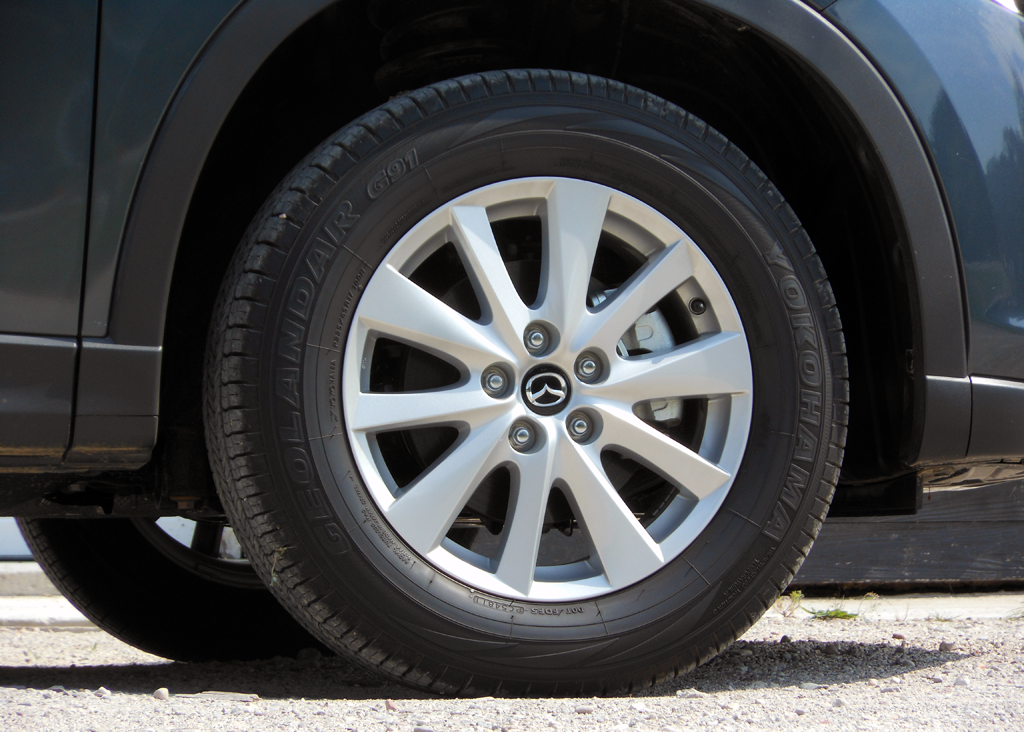William Maley
Staff Writer - CheersandGears.com
September 6, 2012
Mazda is not in the best of health. The past year has been a struggle for the ’zoom-zoom’ brand; Mazda’s growing reliance on their plants in Japan despite other automakers leaving to other places due to the rising yen, leaving the production line at the Flat Rock, MI plant, laying off workers at their U.S. headquarters, and other troubling news, all contribute to a disconcerting future.
The company is banking on two items that will hopefully begin to turn their fortunes around. The first item is the new SKYACTIV technology which is claimed to improve fuel- efficiency while keeping the ‘zoom-zoom’ the brand is known for. The second item is Mazda’s new compact crossover, the CX-5. The new crossover will be featuring the full suite of SKYACTIV and new design language that will be appearing on future Mazdas. Can SKYACTIV deliver on its promises? Is the new CX-5 the vehicle to begin turning the tide?
Next: Outside
Exterior
The CX-5 is Mazda’s first production model to use their new Kodo ("Soul of Motion") design language. Overall, the design is almost a carbon copy of the Minagi concept shown at the 2011 Geneva Motor Show. Up front, the most prominent design cue on the CX-5 is the large, five-point grille. This takes the place of the goofy smile grille that is prominent on many Mazda vehicles. Sitting on either side of the grille are a set of optional HID headlights (come as part of the $1,185 tech package). Along the side, Mazda has extended the line running along the front fenders partway into the front doors. Mazda also has a distinct character line running along near the bottom of doors, looking like a wave. The back end has a rounded shape, which is partly hidden by a spoiler sitting on top.

"What is key is that in any market we operate in, Mazda's market share is small. Our customers are not people who go with the flow, but who make their own decisions and want something distinctive. That gives me lots of freedom," said Mazda’s chief designer, Akira Tamatani when asked about the design of the new Mazda CX-5 and 6.
We think Mazda has succeeded on making the CX-5 very distinctive from its counterparts.
Next: Inside
Interior
Distinctive isn’t the first or last or any word I would use to describe the interior of the CX-5. The interior design is very plain and the use of black throughout the interior can make you feel somewhat depressed. I wished Mazda could have taken some of Kodo design cues from the exterior or use some other color in the interior. Otherwise, the interior materials are the class average. Fit and finish is excellent.

The CX-5 Touring comes with standard cloth seats. The seats provide enough adjustments to find a comfortable position, and have enough bolstering to keep you and your passengers in the seat whenever you decide to go for a run. Backseat passengers will find enough room for their head and legs. However, if you decide to take the CX-5 on a long trip, be prepared to pack a pillow or two. The seats don’t have enough padding for long distances and you will be aching when you get to your destination.
As for standard equipment, the CX-5 Touring comes pretty loaded. You get keyless entry and ignition, a leather-wrapped steering wheel, 5.8-inch color display for the radio, and AM/FM/HD/CD/Aux/USB/Bluetooth audio system.
Mazda has done something interesting with the optional navigation system on the CX-5. Like Chrysler, Mazda has turned to a navigation company, TomTom in this case, to provide maps and data. The system worked perfectly and was able to get me to wherever I needed without any problems. My only wish is that Mazda could have made the screen a little larger than 5.8-inches.
Next: Under the Hood
Powertrain
Before we go into the CX-5’s powertrain, it would be a perfect time to explain what the big deal is with Mazda’s SKYACTIV technology. SKYACTIV is Mazda’s umbrella term for their new technology used in its new powertrains and weight-loss (we’ll dive into that when we get to the ride and drive section), which is aimed to improve fuel economy while keeping the zoom-zoomness. The first half of the SKYACTIV tech appeared this year in the compact Mazda3; the 2.0L SKYACTIV-G four-cylinder and the SKYACTIV-Drive six-speed automatic.
Mazda put a lot of engineering effort into the 2.0L SKYACTIV-G to make sure they met their goals of performance and fuel economy. The 2.0L includes direct-injection, a special exhaust manifold which allows the engine compression to be at an impressive 13:1 ratio, and a unique piston design. Those efforts led to the 2.0L SKYACTIV-G to produce 155 HP (@ 6000 RPM) and 150 lb-ft of torque (@ 4000 RPM). A lot of work also went into the SKYACTIV-Drive six-speed automatic. When leaving from a stop, the transmission uses a torque converter to get you going very smoothly. Once the CX-5 reaches a certain speed, the torque converter locks up and the transmission switches to a clutch pack, which makes every makes every shift happen quickly.

This combination allows the CX-5 to return some impressive fuel economy numbers. The EPA puts the CX-5 Touring with front-wheel drive at 26 City/32 Highway/29 combined. All-wheel drive drops fuel economy to 25 City/31 Highway/28 combined.
Does the SKYACTIV powertain deliver on its promises? Almost. The 2.0L SKYACTIV-G doesn’t have enough low-end torque to get you on your way from a stop as quick as you would like. There is a SKYACTIV Diesel engine coming and a rumored 2.5L SKYACTIV-G being prepared for next model year which could solve this problem. Plus, the six-speed automatic is slow to react whenever you need it needs to downshift, causing the you to either push further down on the accelerator or throwing the transmission into the manual mode and downshift yourself.
Otherwise, the SKYACTIV powertrain is an amazing feat of engineering. Once you’re on your way, the 2.0L keeps up with traffic very well, whether in the city or on the highway. The six-speed automatic delivered smooth and quick shifts. Then there’s the fuel economy. On the first day I had the CX-5, I got 29 MPG driving on suburban roads. Not bad for a crossover I thought. The rest of the time, the CX-5 and I went to Northern Michigan for vacation where it averaged an impressive 37 MPG on rural and highway roads.
Next: On the Road
Ride & Drive
We explained one half of Mazda’s SkyActiv technologies, the powertrain in the last section. Now it’s onto the other half of the SkyActiv, the weight-loss. The CX-5 is the first Mazda vehicle to be built from the ground up with this idea. The body is this first application of a new lightweight steel which allows the vehicle to shed weight while retaining rigidity of regular steel. Mazda also cut weight wherever they could, right down to the bolts used in the vehicle. This weight-loss not only helps in the fuel economy, it also makes the CX-5 more agile when driving enthusiastically.
Along with the light-weight mantra, Mazda uses independent front and rear suspension, and an electric rack-and-pinion steering system. This combination makes the CX-5 a joy to drive on your favorite road. The suspension reduces body roll and keeps the CX-5 stable when corning. The steering is weighted just right and provides the same feel and accuracy like you would find on smaller Mazdas. When taking the CX-5 on the test loop I put all of the vehicles in for evaluation, I had to keep reminding myself; this is a crossover, not a sports car.

As for driving around to get to work or other places, the CX-5 provides a composed and well-damped ride on smooth surfaces. On rough roads, the CX-5 could use a little bit more damping as some bumps and jostles make their way inside. On the highway, there is minimal wind, road, and engine noise. Visibility is good in the front and side. Rear visibility is poor due to the large d-pillars, but Mazda does make a rear-view camera standard on the Touring model.
Next: The Verdict
Verdict
Mazda deserves a pat on the back with the new CX-5 and SKYACTIV. The SKYACTIV technology almost delivers on its promise of delivering performance and fuel economy in one package. The CX-5 is one of the best driving and best looking small crossovers on the market. Combine the two together and what you get is one very good crossover.
There are some faults to CX-5 though. The interior is very plain when compared to the exterior and the seats could use a little bit more padding. Also, the 2.0L SKYACTIV-G engine needs a bit more oomph on the low-end and the six-speed automatic needs to be quicker on the downshifts on certain situations.
Mazda put a tall order on the CX-5 and SKYACTIV to begin reversing their poor fortunes. Judging from the sales charts, it looks like Mazda is starting to slowly turn around to a better time.

Disclaimer: Mazda provided the vehicle, insurance, and one tank of gas
Cheers
Distinctive Exterior Styling
Impressive Fuel Economy
Loads of standard equipment
Smooth and quick automatic transmission
Handling in sporty and normal driving
Light curb weight
Back seat space
Jeers
2.0L lacking low-end oomph
Six-speed slowness to downshift in certain situations
Interior lacking some pizzaz
Seats lacking in padding
Year - 2013
Make – Mazda
Model – CX-5
Trim – Touring
Engine – SKYACTIV-G 2.0LFour-Cylinder
Driveline – Front-Wheel Drive, Six-speed automatic
Horsepower @ RPM - 155 @ 6000
Torque @ RPM – 150 @ 4000
Fuel Economy: City/Highway/Combined – 26/32/29
Curb Weight – 3272 lbs
Location of Manufacture – Hiroshima, Japan
Base Price - $23,895.00
As Tested Price - $27,005.00* (Includes $795 Destination Charge)
William Maley is a staff writer for Cheers & Gears. He can be reached at [email protected] or you can follow him on twitter at @realmudmonster.




-3707742431.jpg.06edf8e14f4ccf35c60d4774a543cc11.jpg)



Recommended Comments
There are no comments to display.
Join the conversation
You can post now and register later. If you have an account, sign in now to post with your account.
Note: Your post will require moderator approval before it will be visible.